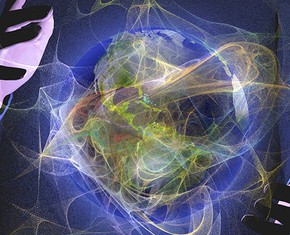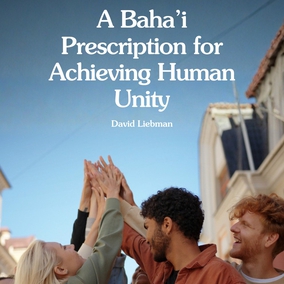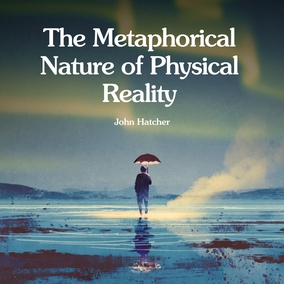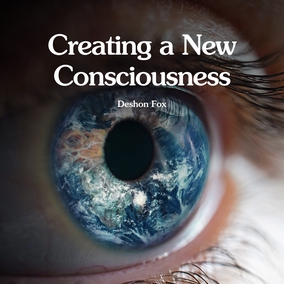The views expressed in our content reflect individual perspectives and do not represent the authoritative views of the Baha'i Faith.
Most kids understand that an asteroid impact killed the dinosaurs, striking the Earth 65 million years ago, the atmospheric dust shutting off the sunlight dinosaurs needed to survive.
How do we know? Well, geologists discovered a thin layer of sediment they call the K-Pg boundary, which stands for the Cretaceous–Paleogene extinction event, in both marine and terrestrial rocks all over the world. That thin, dark boundary, once atmospheric dust but now hardened into rock, has very high levels of the rare metal iridium—rarely found in the Earth’s crust, but highly prevalent in asteroids. Then, in the 1990s, scientists discovered the huge, 100-mile wide Chicxulub crater under the ocean in the Gulf of Mexico—and finally connected those two facts, which happened at exactly the same time.
Interestingly, many scientists now believe that this best-known mass extinction didn’t only come from that gigantic asteroid and the “impact winter” it caused—but that it was also partially caused by volcanic eruptions, rapid sea level alterations and carbon cycle-driven climate change over a period of several centuries. These theories raise some interesting questions: could those same things possibly occur now, and if they did, would human beings possibly become extinct?
To answer those questions, let’s review: the K-Pg boundary wasn’t the Earth’s only mass extinction. Over the course of our planet’s known history—about four and a half billion years—we’ve detected five major mass extinction events. Or maybe six.
Here are the scientific names for the so-called “Big Five” extinction events, from first to the most recent:
- The Ordovician–Silurian, which happened about 450 million years ago;
- The Late Devonian, which occurred 360-375 million years ago, and may have also been caused by an asteroid which struck what is now central Sweden in an area named the Siljan Ring;
- The Permian–Triassic extinction event, about 252 million years ago, which scientists call “The Great Dying,” because it wiped out up to 96% of all sea life and 70% of land-based vertebrate species;
- The Triassic–Jurassic extinction event; about 201 million years ago, which killed half the species on Earth at the time and ushered in the age of the dinosaurs;
- and The Cretaceous–Paleogene, the asteroid, volcano and climate change-caused extinction event which brought us from the dinosaur age to our current Cenozoic Age, also known as the Age of Mammals.
If you study these five great mass extinctions, you’ll find several credible theories about what caused them. One of the most prominent is the rapid cooling or warming effects of climate change, brought on by asteroid strikes or multiple volcanic eruptions that emitted huge volumes of carbon dioxide into the atmosphere. We know that the Earth’s carbon cycle was disrupted in each of those five mass extinction events, and that consequently the atmosphere warmed or cooled dramatically during those periods, because today we can measure the past presence of carbon in ancient ice cores at the poles.
So what’s that sixth mass extinction event? It’s the one we’re in now, the one scientists call the Holocene event, or the Anthropocene, or the Sixth Extinction. This one, however, isn’t caused by asteroid strikes or volcanoes—it’s caused by humans.
How? We humans, through our activities, have managed to disrupt the natural processes of the planet by degrading biodiverse habitats like rainforests and coral reefs. We’ve hunted and killed off much of the Earth’s megafauna, the large mammals and apex predators at the tops of food chains. We continue to consume a large percentage of the world’s natural resources, driving scarcity for other life forms. We’ve acidified the oceans with our emissions of carbon dioxide from the burning of fossil fuels. We’ve cleared much of the world’s arable land for farming, and our agricultural practices, especially the use of pesticides, fungicides and insecticides, have harmed and continue to harm the ecosystem. In sum, we’ve become the apex predators, and our increasing population numbers—now more than 7 billion—continue to decimate the natural environment at an unsustainable and unprecedented rate.

Could humanity itself become extinct? Yes, of course. We’re mammals, and despite our resourceful brains and our remarkable adaptability, the Sixth Extinction could potentially wipe us out, too. In fact, recent research at MIT has shown that we have the rest of this century, until about 2100, before our unchecked human activities could completely destabilize the oceanic ecosphere, spinning the Earth’s natural balance so far out of control that it would trigger a rapid catastrophic spike in the Sixth Extinction.
From a Baha’i perspective, these frightening scientific projections sound yet another urgent alarm to all humanity, first issued by the message of Baha’u’llah in the 19th Century. That Baha’i message asks us to unite to reform “the material and physical world” and usher in a new spiritual springtime in the collective life of humankind:
… we must strive with life and heart that the material and physical world may be reformed, human perception become keener, the merciful effulgence manifest and the radiance of reality shine. Then the star of love shall appear and the world of humanity become illumined. The purpose is that the world of existence is dependent for its progress upon reformation; otherwise, it will be as dead. Consider: If a new springtime failed to appear, what would be the effect upon this globe, the earth? Undoubtedly it would become desolate and life extinct. The earth has need of an annual coming of spring. It is necessary that a new bounty should be forthcoming. If it comes not, life would be effaced. In the same way the world of spirit needs new life, the world of mind necessitates new animus and development, the world of souls a new bounty, the world of morality a reformation, the world of divine effulgence ever new bestowals. Were it not for this replenishment, the life of the world would become effaced and extinguished. If this room is not ventilated and the air freshened, respiration will cease after a length of time. If no rain falls, all life organisms will perish. If new light does not come, the darkness of death will envelop the earth. If a new springtime does not arrive, life upon this globe will be obliterated. – Abdu’l-Baha, The Promulgation of Universal Peace, p. 279.
Baha’is believe that we cannot achieve the global reform necessary to avoid that obliteration with our current mechanisms, leaders, treaties, systems and governments. Instead, we need a completely new light—the light of revelation.
















Comments
Sign in or create an account
Continue with Googleor